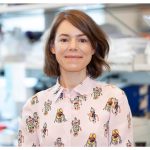
Funded by the Dick Vitale Pediatric Cancer Research Fund
Within days of birth, trillions of harmless, and even beneficial, bacteria colonize an infant’s skin and gut. The developing immune system must learn to tolerate these “commensal” bacteria to avoid the onset of destructive inflammatory diseases such as eczema and inflammatory bowel disease. Remarkably little is known about the cell types that instruct immune cells to accept commensal bacteria in early life. Our research will address the cross-talk between microbes and the developing immune system to elucidate the mechanisms by which the host and bacteria learn to develop a harmonious, symbiotic relationship. In this effort, we seek to reveal the role of a newly identified, early-life immune cell in establishing acceptance of commensal skin microbes. Overall, the project is expected to provide insights into basic mechanisms of immune-regulation, clues to pediatric inflammatory diseases, and a path to the development of new therapies.

Funded by the Dick Vitale Pediatric Cancer Research Fund in memory of Colby Young
Children with changes in a pair of related genes (named DROSHA and DICER1) can get cancer in their lungs, muscles, kidneys, brains, and other organs. This is because DICER1 and DROSHA normally turn off pro-growth signals. When these pro-growth signals cannot be turned off, cancer can arise. We do not know which pro-growth signals are most important. Our lab found that one of these pro-growth signals, named Igf2, may be one of the most important. We came across this idea through studying mice that develop brain cancer due to Drosha changes. This project will study how important Igf2 is. It will also examine exactly how Igf2 gets turned on. Lastly, it will test whether a drug that targets Igf2 will be effective in these cancers.

Funded by the Dick Vitale Pediatric Cancer Research Fund
Medulloblastoma is the most common brain tumor in children. While doctors can cure most of these children, the treatments are very toxic and negatively impact these patients and their families for the rest of their lives. Thus, scientists are trying to finding new therapies that are more effective and less toxic. A handful of new drugs have been tested in the last few years in patients with medulloblastoma. Most of these new drugs initially show great efficacy. Unfortunately, tumors rapidly become resistant and return more aggressively. Sadly, when these tumors come back there is no good treatment available and most of these children die. Therefore, it is very important to find drugs that can stop the growth of the tumors and prevent their reappearance. A series of experiments allowed us to find an ideal candidate therapeutic for children with medulloblastoma tumors. These compounds that target a family of proteins named BET, will reduce the size of the tumors and prevent them from growing back in the future. We believe that our research will provide a game-changing therapy for patients with medulloblastoma and restore hope in these children with cancer and their families.

Pancreatic cancer is a deadly cancer. There are urgent needs to identify specific biomarkers in blood (proteins and metabolites) that are related to pancreatic cancer. The increased understanding of risk factors for pancreatic cancer can be useful to develop new strategy for predicting individual risk of developing this cancer. The proposed study using novel design and methods will help identify protein and metabolite biomarkers in blood causally associated with pancreatic cancer risk. Knowledge generated by this project will help us to better understand the etiology of pancreatic cancer and lay a solid foundation for future efforts of risk prediction of this deadly cancer. The identification of high-risk individuals can be useful for more specific, expensive, and/or invasive tests to identify disease at an early stage or for targeted prevention to reduce disease risk.

Colorectal cancer is the second leading cause of cancer related deaths worldwide. Alarmingly, recent studies show that its incidence is increasing in younger adults. Certain environmental factors, such as diet, can have an impact on colorectal cancer. Calorie dense, western diets can lead to energy imbalance and excessive weight gain, which is associated with higher risk of colorectal cancer. Since diet is a modifiable risk factor, it is important to understand precisely how diet composition and particular nutrients within the diet can affect colon tumor cells directly and indirectly. We plan to systematically examine how colon cancer cells become dependent on certain nutrients that are necessary for rapid tumor growth and progression. We will also test how relevant dietary nutrients, such as sugars and fats, change the function of support cells found within the tumor and influence tumor growth. Our hope is to identify vulnerabilities in colon cancer cells that we can enhance through nutrition and develop new treatments that will improve survival and quality of life for cancer patients.

The goal of this project is to make new drugs against ovarian cancer genes using a new drug discovery method. Ovarian cancer (OC) remains a deadly disease. OC will be diagnosed in over 21,000 women in the United States this year and 13,770 patients are expected to pass away during this time. While initial responses to the best anti-cancer drugs are frequent, most patients with OC will experience disease again after 24 months of treatment, and most women will unfortunately pass away from this disease within five years. Thus, there is an urgent need to make new drugs to treat ovarian cancer. The classic approach to drug discovery is both time intense and costly, and most cancer drug discovery is focused on making drugs against cancer proteins whose shape is considered readily ‘druggable’. Our central premise is that many ovarian cancer proteins can be drugged. To test our idea, we will use a new tool that finds druggable proteins by detecting drug binding to cancer causing proteins in OC cell lines and patient tumors. If successful, this program should develop a new class of anti-cancer drugs to help women suffering from OC.

Fighting cancer is like a game a chess: each treatment can be followed by the adaptation of the tumor. Our next move requires the development of a novel treatment strategy. This is however a difficult task.
My research goal is to develop novel strategies to treat breast and ovarian cancers that are resistant to common drugs. Many breast and ovarian cancers are no longer capable to correctly repair DNA when it is broken. This Achille’s heel can be used to eliminate cancer cells without damaging healthy tissues. My research team has identified a novel protein that help repair DNA and that is essential in these cancers. Our goal is to develop a drug against this protein and to test if we can use it to kill certain cancers that became resistant to current treatments.

Funded by the Constellation Gold Network Distributors
Genetic information is carried in DNA, which is present in every cell of our bodies. Most cells have 46 chromosomes, which carry DNA within the cell. However, more than 90% of tumors have cells without the correct number of chromosomes. These cells are called “aneuploid”. Some whole chromosomes or large chromosome fragments may be duplicated or lost. Aneuploidy is a contributing factor in cancer formation. However, its exact role in this process is an unanswered question in cancer biology. The goal of this research is to understand the effects of different changes in chromosome number.
For our studies, we make use of a new technology that allows us to cut chromosomes at specific locations. With these experiments, we can study the effects of changes in large chromosome segments. Our current focus is a type of cancer called squamous cell carcinoma (SCC). In this cancer type, large pieces of chromosome 3 are affected. Here, we will uncover the interaction between chromosome 3 changes and DNA mutations. We will also create a human cell model of SCC. These studies address a gap in our understanding of aneuploidy in cancer by studying the effects of specific sets of chromosomal changes. With knowledge of how these chromosomal changes contribute to cancer formation, we will uncover new ways that cells can become cancerous. A better understanding of paths to disease formation will be crucial for designing new cancer treatments.

Harnessing the immune system to eliminate tumor cells has led to remarkable responses in several advanced cancer types. T cells are the key immune cell type which are engineered in the lab to seek out and destroy tumor cells, however in many cases tumor cells adapt to evade T cell killing, leading to disease relapses. Advances in cell engineering now permit T cells to be made in the lab from specialized stem cells. This technology promises to provide more cancer patients access to T cell therapies, but also presents the opportunity to make T cells more effective in prevent tumor escape. The goal of this research project is to study the ways in which tumor cells evade killing by lab-grown T cells, and how engineering specific molecules on lab-grown T cells may enable us to turn on tumor killing mechanisms to prevent tumor cell escape. Our overall goal is to further the development of this new kind of T cell therapy to be more effective across a wider range of cancer patients.

Funded by the Constellation Gold Network Distributors in honor of the Dick Vitale Pediatric Cancer Research Fund
Brain cancers have recently surpassed blood cancers as the most common cause of cancer-related death in children. The big question we ask here is how we can make cancers easy to destroy from the inside by the body’s own soldiers. Modern cancer-treating drugs utilize the body’s defense mechanism to destroy tumors and have shown promising results against several cancers. However, most of these drugs have been developed against adult tumors and do not always behave similarly against childhood cancers. Furthermore, a lack of suitable targets that can differentiate childhood brain cancers from normal cells prevents the safe treatment of childhood cancers. This is more so due to our lack of understanding by which cancer cells hide from the body’s soldiers, especially in brain cancer. While significant progress has been made in the care of children with medulloblastoma, some of those patients still suffer a lot. The cells create a signal on their surface which identifies healthy cells from diseased cells. It tells a particular type of cell called macrophages not to eat these cells. Macro meaning big and phages meaning eater mean Big Eater. The body uses some proteins to protect cells that should remain and help dispose of diseased cells. Cancers use this to create a force field to protect themselves. In this grant we will test how to reduce this force field on the surface so we can use the bodies soldiers to eat up the tumor.













